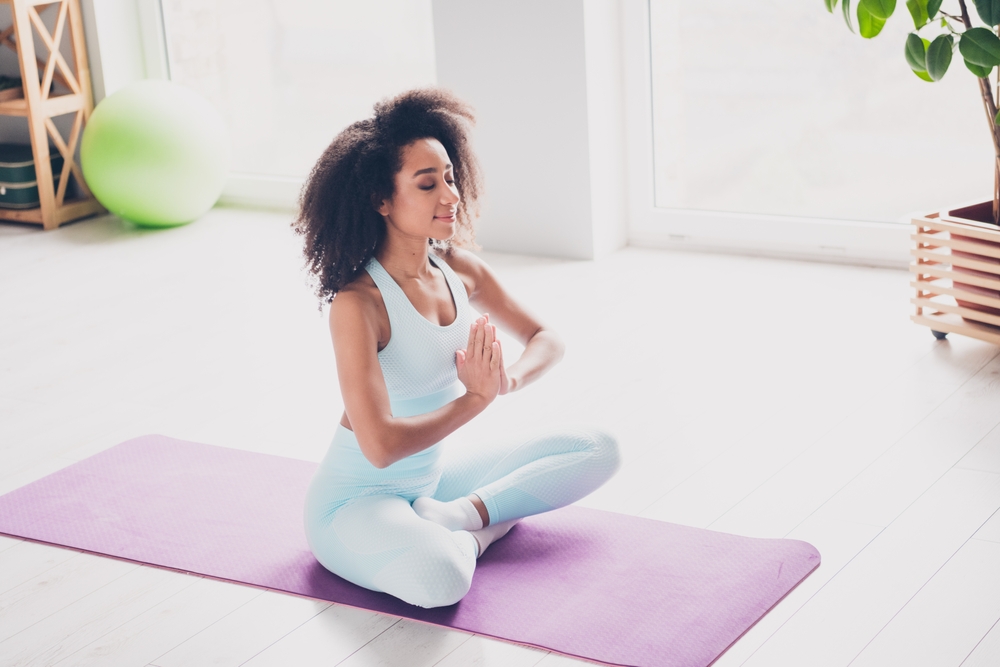You’ve tried the latest productivity apps, downloaded meditation guides that put you to sleep faster than they calm your mind, and cycled through workout trends that left you sore, bored, or both. Meanwhile, your stress levels keep climbing, your focus is scattered, and those nagging aches seem to multiply with each birthday candle.
The solution to this modern muddle might actually be thousands of years old. Yoga—that practice you’ve probably walked past at the gym or scrolled by on Instagram—offers a unique combination of mental clarity and physical healing that addresses the exact issues plaguing our overstimulated, undermoving lives. And unlike the latest wellness fads demanding expensive equipment or impossible lifestyle overhauls, yoga meets you exactly where you are, whether that’s touching your toes with ease or barely reaching your knees.
The most surprising part? The mental benefits might outshine even the impressive physical transformations. That clarity you’ve been chasing through productivity hacks and brain-training apps has been waiting for you on a simple rubber mat all along.
The brain-boosting power hidden in simple poses
The mental clarity that comes from yoga isn’t just anecdotal wellness talk—it’s backed by fascinating neuroscience. When you move through yoga postures while focusing on your breath, your brain undergoes measurable changes that explain why practitioners report feeling sharper, calmer, and more focused.
During yoga practice, your prefrontal cortex—the command center for your most complex thinking—lights up with activity. This area manages your executive functions like decision-making, impulse control, and attention. The deliberate movements combined with breath awareness strengthen these neural pathways, essentially giving your brain’s CEO a serious workout.
Meanwhile, your brain’s default mode network—the circuitry responsible for mind-wandering, rumination, and those spiraling thoughts keeping you up at night—actually quiets down during yoga. This explains the mental clarity that follows practice, when suddenly your priorities seem obvious and solutions to problems appear where before you only saw obstacles.
The deep breathing central to yoga practice triggers your parasympathetic nervous system—your body’s built-in relaxation response. This counteracts the stress hormones flooding your system from constant notifications, deadlines, and modern pressures. The result is a brain state that combines alertness with calm—the perfect condition for clear thinking that evades you when you’re either stressed or sluggish.
Regular practitioners develop increased gray matter volume in regions associated with awareness, attention, and sensory processing. Your brain literally grows in the areas responsible for staying present and processing information clearly. It’s like installing a hardware upgrade for your mental operating system through nothing more complicated than mindful movement.
This brain-changing potential explains why many high-performers across industries have adopted yoga as a non-negotiable part of their success routine. The mental clarity it provides creates a competitive advantage in a world where focused attention has become our scarcest resource.
The physical transformation beyond the flexibility hype
While yoga’s mental benefits might be its best-kept secret, the physical changes it creates extend far beyond the flexibility that gets all the attention. The holistic physical improvements address the exact problems created by our modern, sedentary lifestyle.
The core strength developed through yoga doesn’t just help you hold plank pose longer—it creates the spinal support system that prevents the back pain affecting nearly 80% of adults. Unlike isolated ab exercises, yoga builds functional core strength that stabilizes your entire trunk through natural movement patterns. This translates to better posture, less pain, and more efficient movement in everything from carrying groceries to your favorite sports.
Yoga’s approach to strength building works through isometric holds and bodyweight resistance that develop lean muscle without bulk. This functional strength emerges through movements that mimic real-life activities, creating balanced development rather than the disproportionate patterns often seen with conventional weight training. The result is a body that not only looks proportional but performs optimally in daily life.
The improved joint mobility from regular practice addresses the root cause of many chronic pain issues. Modern life has us locked in the same positions for hours—hunched over screens, seated in cars, and slouched on couches. Yoga systematically moves each joint through its full range of motion, preventing the progressive tightening that eventually leads to discomfort and injury.
Perhaps most valuable is yoga’s impact on fascial tissue—the collagen-based connective network that surrounds every muscle, bone, and organ. This fascial system becomes sticky and rigid through repetitive movements and prolonged postures, creating pull patterns that manifest as mysterious pain that seems to defy diagnosis. The varied movements and sustained stretches in yoga rehydrate and reorganize this fascial network, resolving pain that other approaches often miss.
The balanced nature of a complete yoga practice creates full-body integration that’s surprisingly rare in fitness approaches. While many workout regimens focus on pushing or pulling movements, yoga incorporates rotation, lateral movement, extension, and flexion—covering all movement planes and developing the body as an interconnected system rather than isolated parts.
The quiet revolution in your nervous system
Beyond the visible physical benefits and noticeable mental clarity, yoga creates profound changes in your autonomic nervous system—the control center that manages your stress response, sleep quality, digestive function, and virtually every automatic process in your body.
The conscious breathing patterns in yoga practice directly communicate with your vagus nerve—the information superhighway connecting your brain to your vital organs. Regular stimulation of this nerve through yogic breathing increases your vagal tone, essentially strengthening your body’s ability to recover from stress quickly and efficiently. This improved recovery capacity means the same stressors that once derailed your entire day now create only minor ripples.
This nervous system regulation explains why yoga practitioners experience improved sleep quality, with faster onset and fewer disruptions. The balanced autonomic function helps your body transition more smoothly between alertness and rest, solving the sleep problems that plague millions and further compound stress-related health issues.
The digestive benefits many notice after adopting a yoga practice stem from this same nervous system regulation. Your digestive tract functions optimally only when your parasympathetic system—rest and digest mode—is activated. The twisting postures and diaphragmatic breathing in yoga physically massage your digestive organs while simultaneously creating the ideal nervous system state for proper function.
Your immune system, which communicates constantly with your nervous system, responds to these changes with improved function. Chronic stress suppresses immune response, leaving you vulnerable to everything from common colds to more serious conditions. By balancing stress hormones and reducing inflammation, yoga creates conditions for optimal immune function, explaining why regular practitioners often report fewer sick days.
Perhaps most profound is how yoga affects your perception of pain through changes in your nervous system. Studies show that regular practice actually increases pain tolerance while decreasing pain catastrophizing—the tendency to imagine worst-case scenarios when experiencing discomfort. This dual action transforms your relationship with physical sensations, reducing suffering even when pain itself is present.
How to start when you can’t touch your toes
The beautiful truth about yoga is that its benefits aren’t reserved for the already-flexible or naturally athletic. The practice meets you exactly where you are, making it accessible regardless of your current fitness level, age, or physical limitations.
Begin with simple, accessible poses rather than complex pretzel shapes. Chair yoga, where poses are modified using a sturdy chair for support, offers all the key benefits while accommodating limited mobility or balance concerns. Similarly, wall yoga uses a wall for stability, making standing poses accessible for beginners or those with balance issues.
Focus on consistency over intensity or duration. A 15-minute daily practice delivers more transformative benefits than an occasional 90-minute class. This small, regular dose approach also prevents the soreness that discourages many beginners who attempt too much too soon.
Props aren’t admissions of weakness but tools for proper alignment. Blocks, straps, blankets, and bolsters allow you to access poses with proper form rather than straining into positions your body isn’t ready for. These supports create the conditions for progress while preventing injury.
Find the style that resonates with your needs and preferences. Gentle hatha or slow flow classes provide accessible entry points focused on fundamental alignment. Restorative yoga offers deep relaxation through supported poses held for several minutes. Yin yoga targets connective tissue through longer holds that complement more active practices. More vigorous vinyasa or power styles provide greater cardiovascular challenge once you’ve established foundational skills.
Online options have revolutionized access to quality instruction regardless of location or schedule constraints. Many platforms offer beginner series that progress systematically, allowing you to build skills sequentially rather than jumping into mixed-level classes where advanced variations might be intimidating.
The surprising benefits beyond the mat
The transformation yoga initiates extends far beyond the time you spend on your mat, influencing how you navigate everyday challenges and relating to yourself and others.
Decision fatigue diminishes as your enhanced mental clarity helps you distinguish between essential priorities and distractions. The presence cultivated during practice transfers to daily choices, reducing the mental exhaustion that comes from constant context-switching and information overload.
Emotional regulation improves as the gap between stimulus and response widens. Rather than reacting instantly to triggers, you notice your emotional response building and can choose more skillful actions. This pause between event and reaction transforms conflicts at home and work.
Body awareness developed through practice creates earlier detection of stress signals before they escalate to crisis levels. You notice the tightening jaw, shallow breathing, or hunched shoulders that precede full stress activation, allowing intervention before you’re caught in a stress spiral.
Sleep quality transforms not just through physical fatigue but through the mental clearing that prevents rumination when your head hits the pillow. The ability to direct attention cultivated in yoga helps you disengage from thought loops that normally delay sleep onset.
Relationship quality often improves as practitioners report greater patience, improved listening skills, and more empathetic responses to others. The self-awareness developed through yoga creates greater awareness of interpersonal dynamics, while reduced stress makes you less likely to react disproportionately to minor irritations.
Perhaps most valuable is the shift in perspective that emerges from regular practice. Problems that once seemed overwhelming become manageable challenges. The capacity to remain present rather than projecting catastrophic futures reduces anxiety, while the embodied experience of progress on the mat builds confidence that carries into other areas of life.
The clarity of mind and vitality of body that yoga cultivates isn’t just about performing better in poses—it’s about experiencing your entire life with greater presence, purpose, and pleasure. The practice initiated on a rectangular mat creates ripples that eventually transform your experience of being human in this complex modern world.















